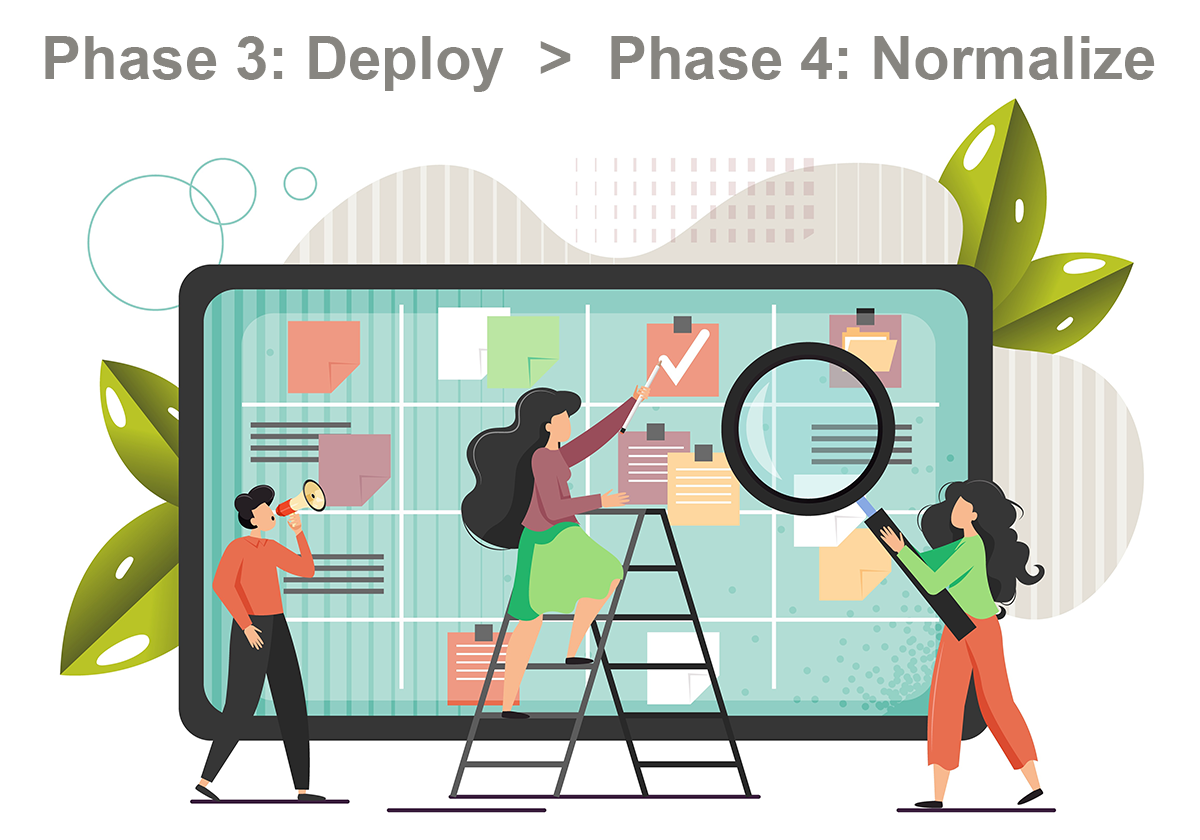Change Management Activities: OCM Phases 3, 4, and 5
Deploying Change Management Engagement and Reinforcing Change
In the ever-evolving realm of change management, OCM Phase 3 marks the pivotal moment when meticulous planning transitions into purposeful action, and involves the deployment of the change management plan. As organizations embark on the execution of their carefully crafted strategies, the third phase of the OCM process becomes the crucible where theory meets reality.
Don’t Miss:
From aligning resources to communicating changes effectively, OCM Phase 3 is the active implementation stage that propels the organization toward its transformative goals.
Phase 3 of the organizational change management process involves dynamic execution, where the resilience and adaptability of the change management plan are put to the test, and leaders play a key role in steering teams through the intricacies of change.

Following the dynamic deployment in Phase 3, the spotlight shifts to Phase 4, underscoring the enduring commitment required for lasting organizational change—the normalization, reinforcement and sustainment phase. In this crucial segment of the change management process, leaders shift their focus to embedding the new practices, behaviors, and processes into the organizational DNA.
Phase 4 is a period of consolidation and fortification, where the emphasis extends beyond initial implementation to fostering a culture that perpetuates and embraces change.
Through targeted reinforcement strategies, organizations not only solidify the gains made in the earlier phases but also lay the groundwork for a sustainable, adaptive, and change-ready future.
The final stage, Phase 5, is about exiting the project, writing a final project report, and doing a knowledge and resource transfer.
Also see: Transitioning Out of a Project That is Completed (Change Practitioners)
Phase 3: Deployment of Change Management Activities
In Phase 3 of your change management activities, the spotlight turns to the dynamic deployment of the meticulously crafted change management plan that emerged during the strategic planning phase. This stage represents the crucial bridge between conceptualization and execution, where change practitioners actively translate their visionary strategies into tangible actions.
This phase is characterized by a palpable sense of momentum and engagement as teams work collectively to bring about the desired changes. It is a stage where the resilience and adaptability of the change management plan are put into practice, and leadership plays a pivotal role in guiding the organization through the complexities and challenges inherent in the journey toward transformation.
Following are activities deployed:
- Deliver Communications: During Phase 3, strategic and targeted communications are disseminated across the organization to convey the purpose, benefits, and progress of the change, fostering transparency and understanding.
- Engage Stakeholders: Stakeholder engagement takes center stage, ensuring open dialogues and involvement to garner support, address concerns, and align the change with organizational objectives.
- Manage Champions: Change Champion/Agent networks are actively supported and guided, leveraging their influence to promote the change, share success stories, and address any challenges that may arise during the deployment.
- Resolve Resistance: Identifying and addressing resistance becomes crucial in Phase 3, employing proactive strategies to mitigate pushback, encourage feedback, and foster a culture receptive to change.
- Deliver Training & Coaching: Tailored training programs are executed, supplemented by individualized coaching where necessary, to empower employees with the skills and knowledge essential for successful adaptation to the new processes or systems.
- Track Change Readiness: A vigilant change management tracking and monitoring system is in place to assess the organization’s overall readiness for change. This allows for real-time adjustments and interventions to address any emerging issues that may impede successful deployment.
- Assess Adoption Readiness: Comprehensive assessments are conducted to gauge the degree of adoption, ensuring that employees are not only aware of the change but are actively incorporating it into their daily workflows, laying the foundation for sustained success reinforcing change management.
Phase 4: Reinforcing Change
The fourth phase of a good change management program comes into play after the change initiative has been deployed (aka: the “go live” date). It involves developing and implementing a change management sustainment plan template aimed at reinforcing the change.
Sustaining a change is critical to the success of an initiative because people have a natural tendency to revert back to the old ways of doing things, or they often develop workarounds to the new solutions for different reasons. To sustain the change, you will need to apply a structured set of change reinforcement deliverables. Follow the steps below to see how to reinforce change during Phase 4.
Change Management Sustainment Plan
- Provide Post Go-live Support: In Phase 4, a dedicated support system is established for reinforcing change and to address any post-implementation challenges, ensuring a smooth transition by promptly resolving issues and assisting employees as they adapt to the change.
- Assess and Track Change Adoption Success: Continuous assessment and change management tracking mechanisms are employed to monitor and measure the success of change adoption, utilizing key performance indicators to gauge the effectiveness of the implemented changes.
- Provide Additional Training as Needed: Remaining responsive to evolving needs, additional training or coaching sessions are delivered as required for the change management sustainment plan. This helps ensure that impacted audiences continue to build competence and confidence in the new processes or systems introduced during the change initiative.
- Recognize & Celebrate Successes and Quick Wins: Celebrating milestones, successes, and quick wins plays a pivotal role in how to reinforce change, fostering a positive organizational culture that recognizes and values the efforts of individuals and teams during the transition.
- Reward Change Champions Network: Acknowledging the pivotal role of the Change Champions Network, tangible rewards and recognition are provided to members, sustaining their enthusiasm and commitment while encouraging a culture of continuous improvement and adaptability.
How Do You Track the Success of Reinforcing Change Managment?
A change management sustainment plan template is only as strong as the ability to track and measure its success. To track the effectiveness of change management activities for reinforcing change, you can leverage the following:
Key Performance Indicators (KPIs)
- Define and monitor KPIs aligned with the objectives of the change.
- Implement change management tracking related to productivity, efficiency, and other relevant performance indicators.
Surveys and Feedback
- Implement regular surveys to gather feedback from employees.
- Utilize feedback forms and suggestion boxes to capture insights on the change process.
Usage Analytics
- Monitor the usage of new tools, systems, or processes.
- Analyze data on how frequently and effectively the change elements are being utilized.
Training Completion Rates
- Track the percentage of employees who have completed required training.
- Assess the effectiveness of training programs by evaluating the understanding gained.
Qualitative Interviews
- Conduct one-on-one or group interviews to gather qualitative insights.
- Seek opinions on the impact of the change on daily work and identify areas for improvement.
Observational Studies
- Observe work processes to understand how the change is integrated into daily tasks.
- Identify any deviations from the planned adoption and address them proactively.
Ticketing System Analysis
- Review support tickets and issue reports related to the change.
- Analyze trends to identify recurring problems and areas requiring additional support.
Timeline Adherence
- Evaluate if the change is being adopted within the planned timeline.
- Identify any delays or accelerated adoption phases and investigate the causes.
Adopting a combination of these monitoring methods for reinforcing change provides a comprehensive understanding of change adoption and allows for targeted interventions as needed.
Do you have any questions about developing a change management sustainment plan or reinforcing change management adoption? Please reach out and let us know.
Phase 5: Change Management Team Transition & Exit
At the end of any transformational change, the change management team will need to transition out of the project. Part of this transition needs to involve a transfer of responsibilities from the change management team to a designated group that will be determined by the program leads. A designated group might be a group within HR, Program Management Office, or some other group.
For small projects, such a transition will be minor. For large projects, the steering committee might need to be involved as such a transition will require careful planning and management. Discussions and interviews with the primary sponsor and the steering committee will be held to:
- Inform them that plans to transfer ownership for the change from the change team to operational managers are being developed
- Determine what outstanding issues need to be addressed prior to the change management team being dissolved
- Work out an acceptable time table for the transition to occur
Sign Up for a Free Account to Access Free OCM Transition & Exit Resources

Looking for some free change management sustainment plan templates and a transition checklist? Access these and over 100 other free resources when you sign up for a Free Account with OCMS Portal.
Key Steps During Change Management Exit
- Implement Transition Plan: In the exit phase of change management, the implementation of a carefully crafted transition plan ensures a seamless shift from active change management to the regular operations, effectively passing the baton to the responsible stakeholders.
- Hand Off Resources: Facilitating a smooth transition, the OCM team systematically hands off all relevant resources, documentation, and responsibilities to the designated individuals or departments, ensuring continuity in the post-change environment.
- Complete Final Report and Recommendations: To encapsulate the project’s outcomes and learnings, the generation of a comprehensive final report and recommendations not only serves as a reflective document but also provides valuable insights for future change initiatives.
- Formally Close the Project: The formal closure of the change management project involves the completion of all administrative tasks, the dissolution of project-specific teams, and the celebration of achievements, marking the official end of the change initiative and paving the way for ongoing organizational success.
FAQ – Change Management Sustainment Plan
What is a change management process in project management?
Change management is the process of working with the individuals and groups being impacted by changes from a particulate project initiative to help them successfully adopt those changes.
What are the 5 phases of the change management process steps?
In the OCM Solution Change Management Framework, the five phases of the change management process are:
Phase 1: Assess
Phase 2: Develop
Phase 3: Deploy
Phase 4: Normalize
Phase 5: Exit
What's involved in the second phase of a change management roadmap?
The second phase of a change management process guide is about using the information from the assessments done in phase 1 to formulate a change management strategy, roadmap, and plan.
Note: Content on OCM Solution's ocmsolution.com website is protected by copyright. Should you have any questions or comments regarding this OCM Solutions page, please reach out to Ogbe Airiodion (Change Management Lead) or the OCM Solutions Team today. OCM Solution was previously known as Airiodion Global Services (AGS).
External Sources: stock.adobe.com




